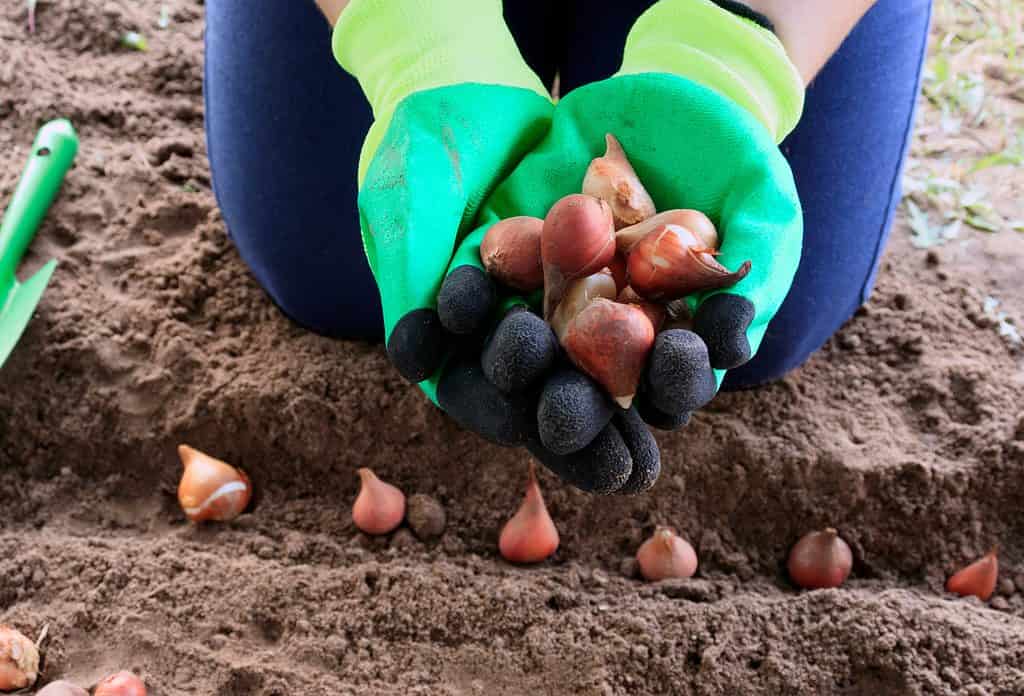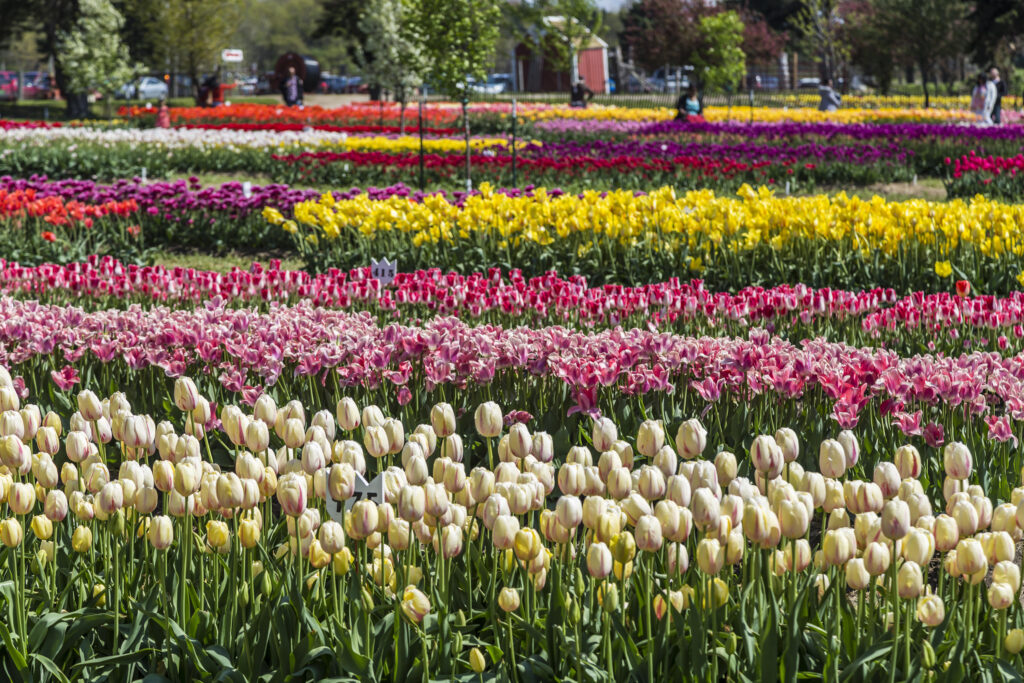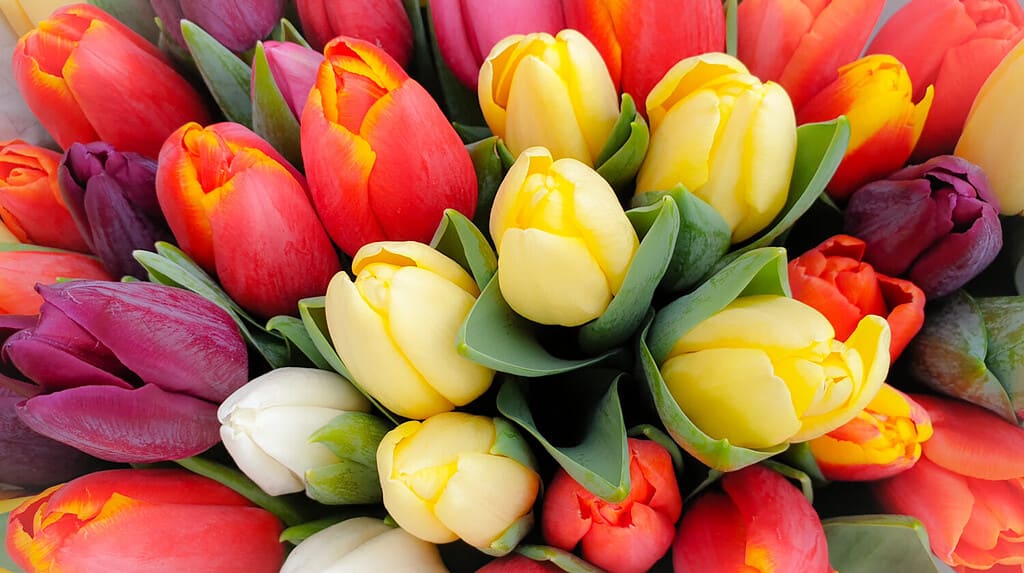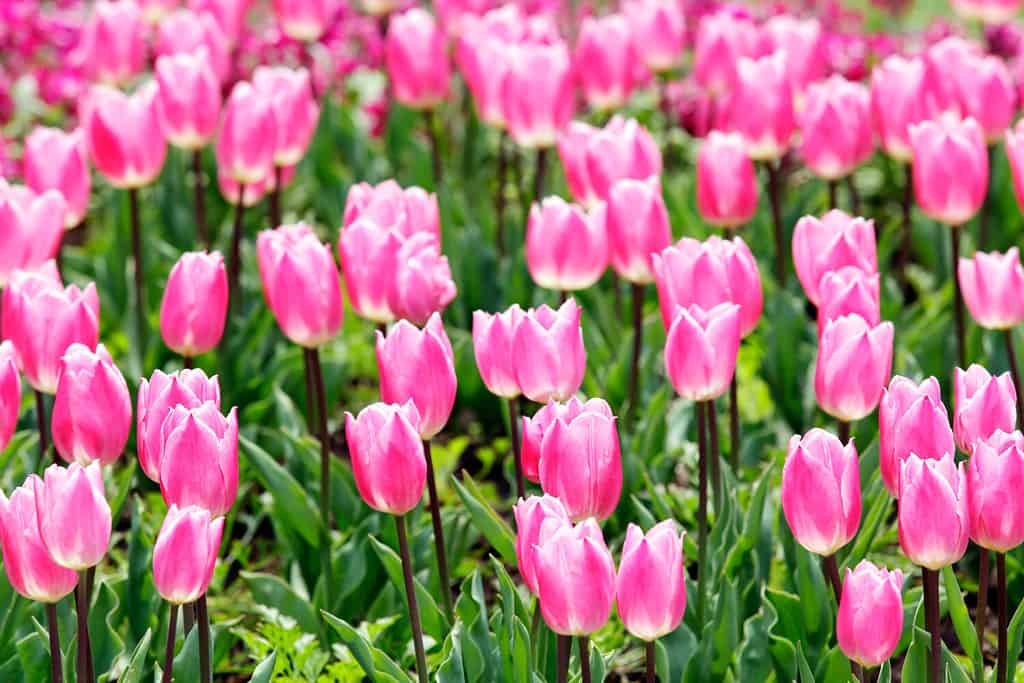Tulips elicit the notion of springtime, new life, new growth, new hope. Planting tulips in Illinois is no exception to this, and, in fact, helps to bring that joy sooner for many. Various varieties bloom earlier than others, so some folks intentionally intermingle several varieties to produce a spring-long chain or tulip blooms.
If you’re thinking of your own tulip garden in Illinois, consider the time for planting, which varieties to choose, where to plant, and how to do it well. Plus, learn about the best festivals, fields, and more in the state for way more blooms than you could ever plant at home.
Are Tulips Perennial Or Annual Flowers?

Tulips come in many varieties and many colors and forms. Unfortunately, many have been so hybridized that they no longer produce flowers perennially. Consider non-hybridized and heirlooms for your best bet at perennial tulips in Illinois.
©Liviu Gherman/Shutterstock.com
Tulips once were primarily perennials. But thanks to the many hundreds of years of hybridization, tulips are now mostly annuals. However, you may plant them in careful ways or provide them with particular care to produce blooms for two years in the annual varieties. Some varieties still bloom year after year, but you’ll need to look for heirloom and non-hybrids for these.
When Should You Plant Tulips in Illinois?

You should plant tulips in Illinois 6 to 8 weeks before the first frost hits in autumn.
©dreakrawi/Shutterstock.com
As spring bulb flowers, tulips should be planted in the autumn. Most experts recommend planting these beauties between 6 and 8 weeks prior to the first frost of the season. Wait until the soil has cooled to about 55 degrees F before planting, especially in the case of years with late-season heat waves.
The USDA Hardiness Zone in which you live will determine when your first frost will fall. Typically, in northern Illinois, this could hit as early as October 13. Mid-state, you’ll probably have another week or so. In the southern end of Illinois, you might make it until the end of October before the first frost.
Planting the bulbs before the first frost by several weeks will allow the plants to establish roots that will be able to tolerate the winter freeze. If they’re planted too early, you’ll find they may be damaged by frost. If you plant too late, your tulips in Illinois won’t be able to put in solid roots and will likely die.
Where to Plant Tulips in Illinois
When the Almanac predicts it’s tulip planting time (6 to 8 weeks before the first frost), be sure to consider the location carefully to help the plants survive now and through the winter into the next year.
- Plant tulips where they’ll get plenty of sun.
- Be sure to prepare the soil with ideal pH levels between 6.0 and 7.0.
- Tulips prefer well-draining soil. This prevents root rot and disease. Make sure they’re not planted in low-lying areas where water collects.
- Ensure the soil is not compacted.
- Prepare the soil with organic matter like peat moss or compost.
- Choose flower beds, raised beds, borders, containers, or just about anywhere that meets the other conditions.
How to Plant Tulips in Illinois

Placement for tulips in Illinois, as well as soil pH, proper drainage, and sunlight needs, are vital for the health of your tulips.
©Natallia Ustsinava/Shutterstock.com
While tulips don’t require a lot of heavy maintenance, they do require some specific care as you plant and raise them.
- Choose the proper location with plenty of sun and well-draining soil.
- Prepare the containers or beds for tulips with proper pH levels and organic matter like peat moss. Ensure the location doesn’t collect water.
- Using a shovel or trowel, dig holes twice the size of the tulip bulbs and about 6 inches deep. Space the holes 4 to 6 inches apart.
- Add fertilizer to the holes, specifically designed for bulbs. Follow the package instructions carefully.
- Place the bulbs into the holes with the pointed ends facing upward. Gently press the bulbs into the holes and cover the bulbs without air pockets in the holes.
- Water the soil immediately to both provide water and help the bulbs settle into place.
- Mulch over the bulbs to retain moisture and regulate soil temperature as winter approaches.
- Be sure to mark the location of your tulips. This will help you make sure that they’re not dug up or damaged during the off months.
Best Tulips Varieties for Planting in Illinois
While you could probably grow just about any tulip variety in Illinois, some will do better here than others. Consider each variety before choosing, though, as each has its own preferences like full sun versus partial shade or preferred USDA Hardiness Zones within your state.
You may also want to consider the varieties based on the colors they come in.
- ‘Apeldoorn’ — large red to orange flowers with black centers
- ‘Orange emperor’ — large, bright orange flowers
- ‘Red Riding Hood’ — red flowers
- ‘Grand Perfection’ — pink to red flowers with scalloped petals
- ‘Purple prince’ — deep purple tulips with a yellow base
- ‘Queen of the Night’ — deep maroon flowers
- ‘White Triumphator’ — large white blooms
- ‘Candela’ — vivid yellow flowers
- ‘Menton’ — soft pink flowers with yellow bases
- ‘Black parrot’ — deep maroon flowers with fringed petals
- ‘Kaufmanniana’ — red, rose, or golden yellow blooms
- ‘Greigii’ — red, orange, yellow, pink, or white blooms
- ‘Rembrandt’ — multicolor blooms
Best Tulip Fields, Festivals, and Views in Illinois

Tulip fields, festivals, and even parks are some of the best places and ways to view tulips en masse. You’d never be able to plant 500,000 tulips in Illinois yourself, so go enjoy someone else’s work at it instead!
©iStock.com/ShriramPatki
While other places in the world may be more well-known for their tulips, Illinois has many wonderful tulip fields and displays. You might be surprised at some of the locations, including one of the busiest pedestrian streets in the Midwest.
Sunken Gardens, Phillips Park, Aurora
Every single year, the Sunken Garden displays over 10,000 hand-planted tulips. The wheelchair-accessible park welcomes visitors with stunning blooms, a triple-tiered fountain, and Phillips Park Zoo, as well, all at no charge.
Kuipers Family Farm Midwest Tulip Fest
Probably the best known, or at least largest, tulip festival in Illinois occurs every year west of Chicago. The 230-acre Kuipers Family Farm welcomes visitors from all over with its magnificent display of tulips with over a half million blooms on just 7 acres of the land.
While visiting the farm, you can enjoy the many amenities in tulip season, including a beautiful event venue and exposure to farm life. In other seasons, the farm hosts apple picking, a pumpkin festival, and more.
Richardson Adventure Farm, Spring Grove
Competing with Kuipers for the most tulips each year, Richardson Adventure Farm definitely keeps up with over 500,000 tulips planted each year. During their tulip festival each spring, they welcome live musicians for the afternoons, guests with pets on leashes, and food trucks. They also host the world’s largest corn maze each fall, with 33 acres of winding paths.
Cantigny Park, Wheaton

Wheaton is known for many things and one of the most gorgeous is Cantigny Park where you’ll see loads of tulips in Illinois.
©Heynicepictures/Shutterstock.com
29 acres of gardens with massive tulip beds welcome visitors with vivid colors each year. Cantigny Park rests within Wheaton and hosts a big playground and picnic area locals love to enjoy while taking in the beauty of the spring blooms. Plus, there’s a war museum, golf course, and more with free admission and minimal parking fees.
Chicago Botanic Garden, Glencoe
Each year as spring hits, the Chicago Botanic Garden, north of the city by 30 minutes, welcomes thousands of tulip blooms. The stunning flowers pop up from April to May in the Circle Garden. After viewing the tulips, head to the model railway garden, Japanese garden, rose garden, and many other unique and beautiful features. The entrance fee varies from day to day, so check for special events and free days. Parking fees are separate.
The Morton Arboretum, Lisle

Be sure to head to the Morton Arboretum for some of the most beautiful tulips in Illinois!
©Alexander Gatsenko/Shutterstock.com
Each spring, the privately owned Morton Arboretum encourages visitors through its gates with the huge variety of stunning tulips they grow. From April to May, the colorful parade of flowers shines brightly solo and intermingled with other gorgeous blooms for the perfect springtime outing.
Magnificent Mile, Chicago
While they aren’t technically tulip fields, the Magnificent Mile’s flower boxes definitely are worth viewing if you happen to be in the city during tulip season. The gorgeous flower beds are filled to the brim with the chosen tulips of the year, usually in many colors and varieties. And bonus! You can shop the Magnificent Mile, enjoy restaurants of many cuisine types, and explore the numerous attractions all while enjoying the tulips.
The photo featured at the top of this post is © Heynicepictures/Shutterstock.com
Thank you for reading! Have some feedback for us? Contact the AZ Animals editorial team.







